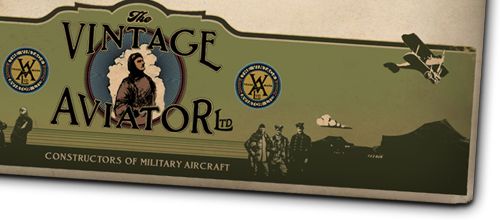You are here
Cowling departs... and the parts pile up.
 “Every flight in a new airplane is an experience, every flight in a rotary powered WWI replica is thrilling. Being at the controls of a Sopwith Camel is truly seat-of–the-pants flying.”
“Every flight in a new airplane is an experience, every flight in a rotary powered WWI replica is thrilling. Being at the controls of a Sopwith Camel is truly seat-of–the-pants flying.”
The pilot must use all of his senses to master this machine, the lack of instrumentation does not inhibit the pilot in this case. There is no oil pressure gage you simply smell the oil and see the tiny oil droplets accumulating on the leading edges of the lower wing. Feeling a vibration may mean that one of the spark plugs has become oil fouled or the mixture is too rich, the wind on your cheek means the turn is not coordinated or the airplane is skidding. The romance of flying these early machines comes from each of these subtle nuances. Only occasionally do these subtleties actually frighten the pilot and even then it rarely hits home until after you have landed…
When Disaster Struck

During the “Classic Fighters 2001” airshow at Omaka on Easter weekend, while flying the Camel, I was reminded of how fragile these aircraft can be. I was engaged in a very special dogfight, pursued by a Fokker Triplane and providing cover for a Bristol Fighter. The three airplanes were flying as planned, the pyrotechnics created a realistic barrage of anti aircraft fire, and the re-enactors on the ground carried out their part to make it all very believable. Just as I made my second or third turn about the field to gain the advantage and dive on the Triplane disaster struck.
At first I wasn’t sure what happened, in fact I started to trouble shoot the problem immediately; loud noise followed by extreme vibration for a moment, something hitting me on the shoulder, rough running engine improving and making plenty of power, airplane still flying, pilot feeling pretty good now. This might not make much sense unless you have experienced some sort of emergency but it is really amazing how quickly we react when we have been trained properly and you have an understanding of the machine you are operating.
My first reaction was remembering an incident involving Cole Palen and a Gnome engine that shed a cylinder in flight. I was certain this was not the case because he said it was the worst thing that had ever happened to him in an airplane, the cylinder tore a hole in the cowling and the fuel necessary to keep the engine running was creating a ring of fire inside the cowl that was starting to escape through the new opening created by the lost cylinder. The other interesting thing about frequently flying different types of aircraft is that you seem to adapt very quickly to the characteristics of each type. This was a great help in this case because the airplane wasn’t flying like a Sopwith camel anymore.

I could hardly turn to the right and the climb performance wasn’t as good as when I took off. A quick look around revealed the reason for the lack of turning ability, a large chunk of aluminum was lodged against the left interplane struts. The big black thing obscuring my view forward was a machine gun- now I wasn’t sure what it was. Within a few seconds (or maybe milliseconds) I realized I had lost the entire engine cowling and there was no way I could defeat the enemy now. Now I really felt bad, the airplane was coming apart, the enemy would get away and I would have to land. Surprisingly the airplane didn’t handle too badly. I made left turns and kept them rather shallow tried to climb knowing I could easily loose the altitude to land. The total loss oil system was working just fine and without a cowling it was covering my goggles faster than I could wipe them clean, good thing I wore that scarf!
The post flight inspection revealed some minor damage to the back of the prop, both machine guns damaged, a few small holes in the fabric, one bent pushrod on the engine and the entire cowling destroyed. I was glad to be on the ground and surrounded by so many friendly faces or maybe they were surprised faces either way I was glad to be there. John Lanham and Ed Storo didn’t miss a beat and continued the aerial action, joining me after the battle in front of the damaged Camel.


